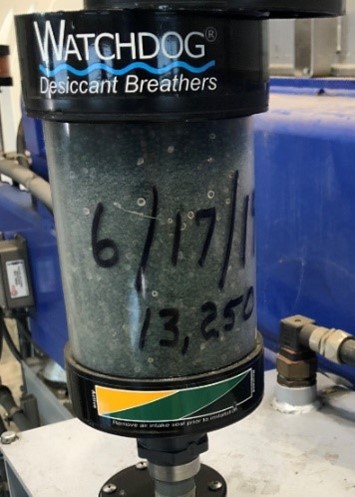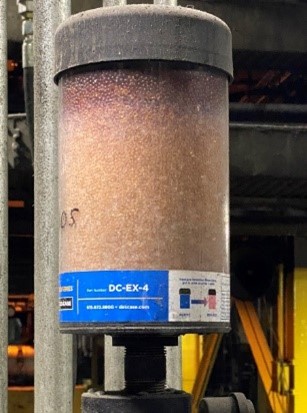
Mike Gauthier
03.30.2021
Don’t forget to change your desiccant breathers!
Desiccant Breathers have been around in our industries for over twenty years now. Most of the plants that I’ve been to typically have some sort of desiccant breather presence. Whether it’s the blue kind or the gold kind, or a mix of the two. They are on all kinds of different equipment from pumps to tanks to gearboxes to mobile equipment. There’s large and small and many different configurations. But the most common thing I see are breathers that are spent way past their useful life. The color change has taken place, or they are completely discolored beyond any usefulness. This product has served as a great weapon against condensation and water ingression for quite some time, but they need to be replaced when spent to be able to protect your equipment from water issues. With the rain and hot/humid season upcoming, here are a couple of tips to keep you on top of your desiccant breathers.
Color Change
Seemingly the most obvious suggestion is to change them when you see them spent. Whether they turn from gold to dark green, or blue to pink, or any other color, this is designed to be a visual indication that your breather needs replacing. This action can be an easy thing to say, “I’ll have to change that sometime”. The problem is that “sometime” becomes “no time” because nobody ever has the time. Keep a public list of spent breathers that you or others see while tending to other, more important priorities. Then, set a specific time, every week or every 2 weeks, to have someone change out spent breathers. It is crucial to keep water out of your equipment, desiccant breathers are the best consistent defense.

Timestamp Your Breathers
When you are installing a new or replacement breather, write the date of installation. Keep a log of how long a desiccant breather lasts in each installation. This can be good information when deciding to change out a breather or not. Over time, this can prove to be important in setting your future schedules for desiccant breather maintenance.
Maybe It’s Time to Upgrade
If you find that you are continuously changing a desiccant breather in a certain application, first check to see why they may be getting spent so quickly. They may be in a high draft area or high volume of air exchange in the application. If the breather application cannot be mitigated, perhaps using a larger breather will extend the time needed between changes. Alternatively, there are many different types of breathers available that may be better suited for your application. When many of the initial desiccant breathers were specified, either the advanced versions were not yet available, or it was based on the lowest cost units. Today’s options include check valves that protect the desiccant from the surrounding environment when it’s not in a dynamic state. They also include purge expulsion ports that allow purged air to expel to atmosphere before having to go through the desiccant. This will save desiccant life as well, extending the time between replacements.

Don’t Forget About Me!
These products are proven to take moisture from the headspace of equipment. It has also been proven that if the headspace is dryer than the oil, moisture will be pulled from the oil. This is obviously good for your equipment – but only when the desiccant has useful life. The important thing for your equipment is, regardless of type or size, is to take time to replace your desiccant breathers when it’s necessary, not when it’s convenient. You might just be preventing a critical failure in the process.
For more information on selection a breather for your application, check out our video.
_______________________________________
**PRODUCT UPDATE 2/1/2024**- Trico is excited to share enhancements across our desiccant breather product line, now featuring both orange/green and blue/pink desiccant options. The EX-series breathers check valves are shielded, ensuring they remain free from clogs and stickiness upon exposure. Additionally, the Particulate Filter is 3-microns crafted from dual-phase micro-glass for superior filtration. The updated Watchdog Desiccant breathers have a versatile “tri-fit” connection, compatible with 1-inch or 3/8-inch male threads, adaptable for NPT, BSPT, or BSPP standards. Discover the new and improved Watchdog Desiccant Breathers today!







